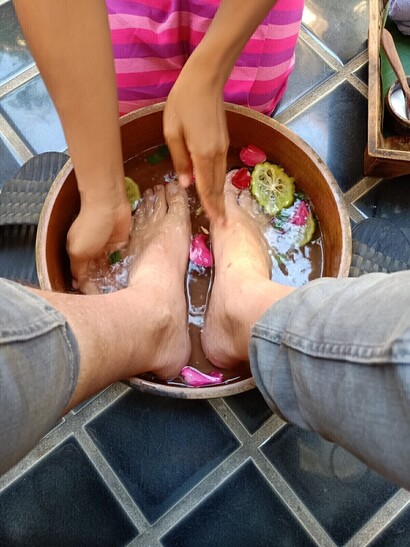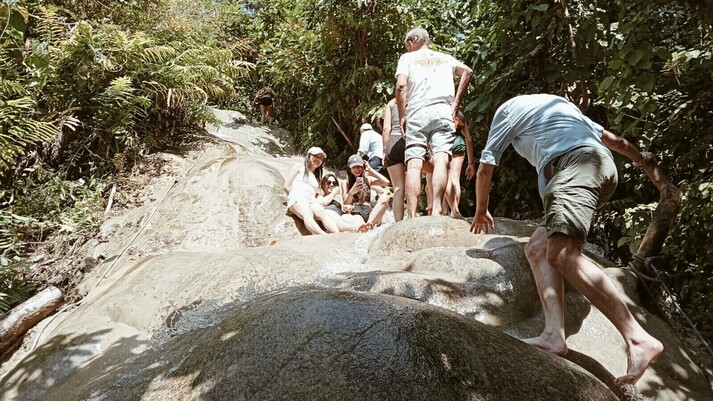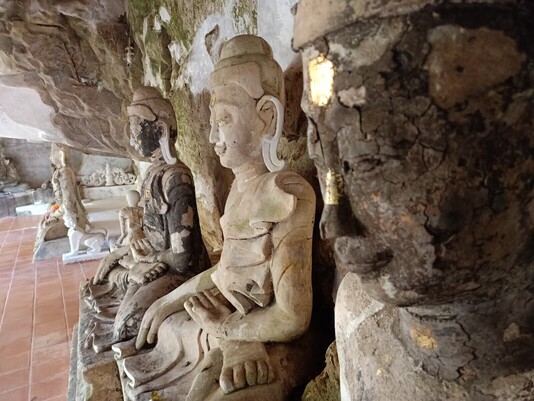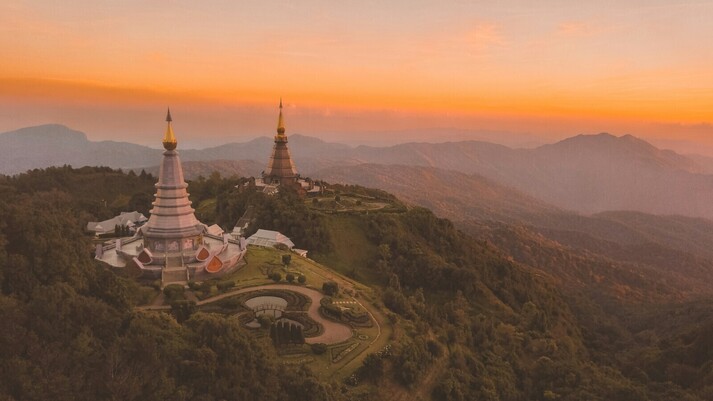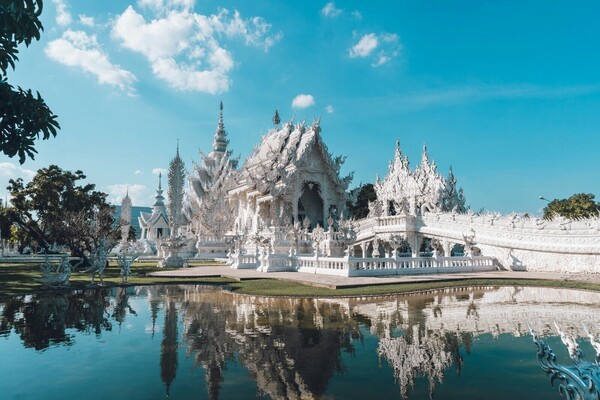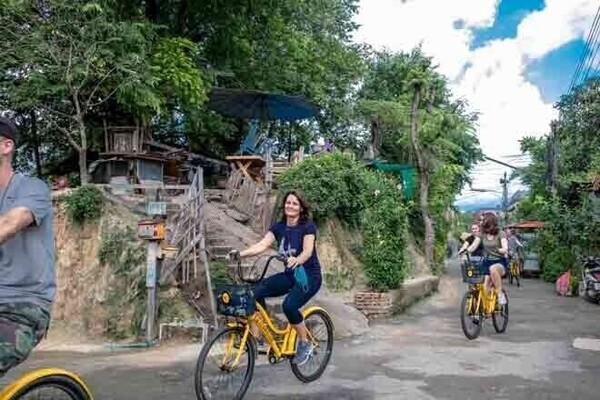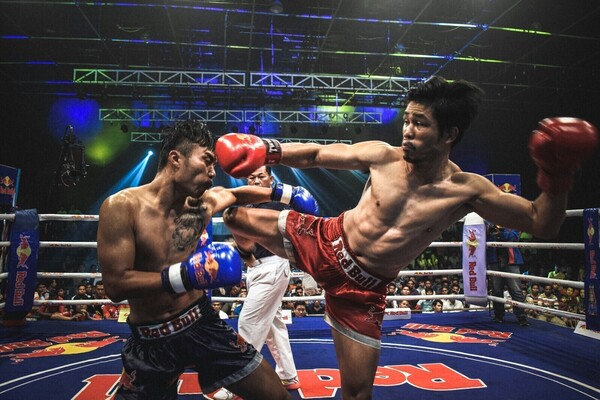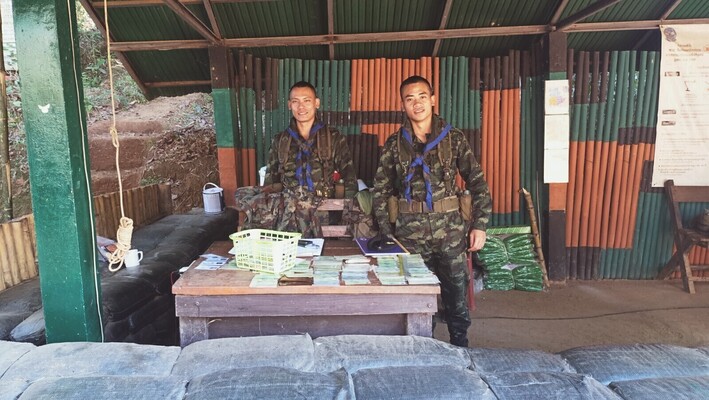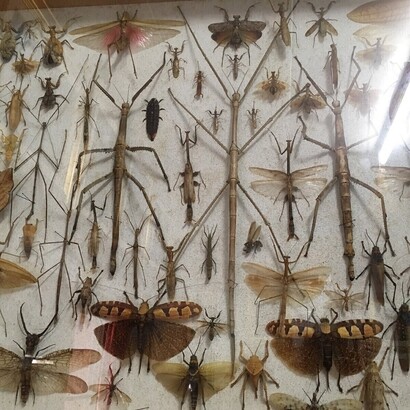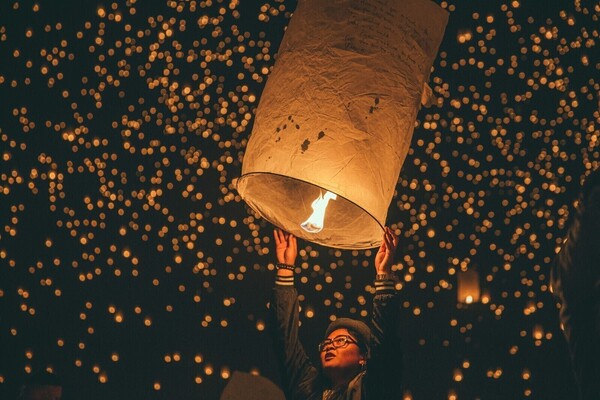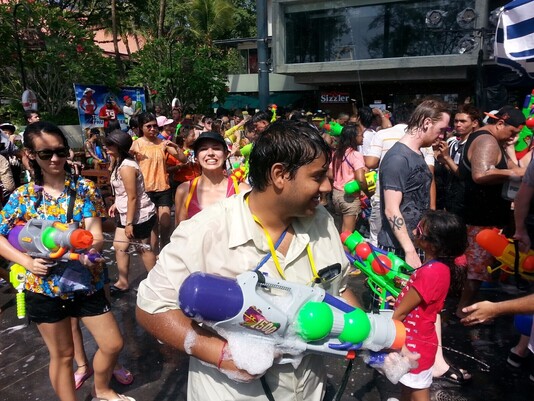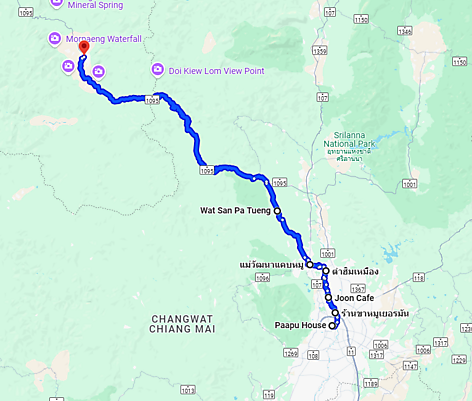-
Sticky Waterfalls
There are plenty of waterfalls around Chiang Mai. Sometimes they’re a bit boring because of the dry season, and sometimes too intense during the rainy season. What makes the Sticky Waterfalls ...

Things to do in Chiang Mai
It’s no punishment to spend a day on a couch or by the pool with a good book or a podcast in your headphones. But if you want to make the most of your (maybe short) time here, it’s worth heading out and exploring (of course, nothing is mandatory — everything is “Up to You”).
Below you'll find an overview of Things to Do in Chiang Mai. Many are easy to do on your own, often within walking distance from your hotel. But for some activities, you'll need a tour. Most trips can be booked online. In the Old City, there are also travel agencies on nearly every street, with brochures casually stacked on the tables. If you’re not here in peak season and have a bit of time, you can easily wait and decide what to book once you’re in town. During high season (November to February), some tours and cooking classes can get fully booked.
One advantage of booking through your hostel is that you’ll usually go with a group — fun and social — and you don’t need to worry whether the driver will find your place.
Note: some links on this page are sponsored links to Get Your Guide
There are dozens of massage shops in Chiang Mai. If you've never had one before, here’s a quick-start guide.
The menus at massage salons almost always look the same:
Thai Massage: this is a firm, full-body massage where your limbs and torso are stretched and pulled. You’ll change into loose-fitting massage pants and a shirt provided by the salon. The women — it’s almost always women who do the massage — will usually ask: “strong or medium?” Don’t be shy: say what you prefer, and if it’s too soft or too hard, just speak up. Expect to pay around 300 THB for one hour, sometimes even less.
You’ll need a magnifying glass to find charming shopping streets — or to be honest, they don’t really exist in Thailand. An afternoon of shopping is best spent like the Thai do: in big, often mega-sized shopping malls, where it’s nice and cool, and where you’ll usually find a food court to grab a bite to eat between stores.
read moreSpending a few days meditating at a retreat center — it's one of the reasons people come to Chiang Mai. All meditation centers are located a bit outside of Chiang Mai, usually surrounded by nature and often connected to a monastery. Here are a few recommendations:
Wat Sopharam – About 35 km southwest of Chiang Mai
Wat Chom Tong – Just outside Chiang Mai
Wat Pa Tam Wua – Located beyond Pai
Pa Pae Meditation Retreat – Halfway between Pai and Chiang Mai
Chiang Mai is also a popular destination for yoga. You can even join daily sessions in 'the park'.
In Chiang Mai, you can visit an Elephant Sanctuary — but the topic of the day is whether it’s truly “ethical” to do so. Most of these sanctuaries use the word “ethical” at least ten times on their websites, aiming to attract visitors who are specifically looking for a so-called ethical park.
In practice, “ethical” usually means “no touching,” and you often pay extra for that. The most common type of sanctuary involves feeding the elephants, throwing water over them, and taking a dip with them. You can’t go there on your own; you’ll always be picked up at your hotel or hostel.
For example, check out Mae Rim Elephant Sanctuary
Or one that’s known for its strict ethical policy — strictly observation only, no touching:
Elephant Nature Park
A complete overview can be found here.
Another very popular activity in Chiang Mai is a cooking class. Definitely recommended! You'll head to the market with a small group, get an introduction to typical Thai herbs, spices, and ingredients, and then prepare several dishes of your choice — which you’ll then enjoy together. You eat what you cook.
There are dozens of options — just Google “Chiang Mai Cooking Class” and you’ll be served a whole menu of choices. And of course, they’re all “organic”...
You can choose between a morning or afternoon class, followed by lunch or dinner, respectively. Pay attention to the location as well — a few schools are in the city, but most are located in the countryside, such as the lovely Smile Organic Farm, where you also get a farm tour. Expect to pay around 800–1000 THB per person.
A full overview of cooking schools is available on Get Your Guide – Cooking Classes.
About 30 to 40 kilometers outside Chiang Mai, especially towards the north, there are quite a few programs offering more active trips: rafting, trekking, and often combination tours. With the rise of conscious tourists, more and more organizations also offer visits to elephant sanctuaries with a 'hands-off policy'.
You can easily book more tours, especially combination tours, via Get Your Guide.
Here are a few websites that organize these kinds of activities:
There are plenty of waterfalls around Chiang Mai. Sometimes they’re a bit boring because of the dry season, and sometimes too intense during the rainy season. What makes the Sticky Waterfalls special is that you can climb up barefoot from bottom to top. The rocks aren’t slippery, but... sticky. It’s a bit of a tourist trap, but you can take great photos for your Instagram and spend about an hour there. Entry is free, but you need to register upon arrival. Swimwear is allowed, but you can also climb up fully clothed.
How to get there: there aren’t really organized tours to the Sticky Waterfalls, but if you stay in a hostel, they often organize a red taxi a few times a week that takes a group there, waits, and brings you back. Sometimes the Sticky Waterfalls are part of a day tour offered by a tour operator. If you gather a few people, you can also book a red taxi yourself. Expect to pay around 500-800 THB for a round trip.
You can also get there by scooter (but first read the text about traffic and renting a scooter in Chiang Mai): if you do, follow the walking route to the Sticky Waterfalls on Google Maps. The first 10 km are still within Chiang Mai’s urban area, but after that the road gets quieter and eventually takes you through forests and past lakes. This way you avoid the main highway to the Sticky Waterfalls. Only ignore the last few kilometers of walking instructions, because Google literally sends you into the forest — so always stay on the paved road.
On the mountain next to Chiang Mai lies the temple 'Wat Suthep'. The mountain is called Doi Suthep. You can get there by a winding drive of about half an hour from the old city, but you can also hike there. The hike takes about 2 hours. The first 45 minutes the path gradually goes uphill until you reach your halfway bonus: Wat Pha Lat. It is a very pleasant jungle temple, not touristy at all because all taxis and buses speed past here to Wat Suthep. There are a few old buildings, a small temple in a cave, a waterfall on the grounds — nice enough to soak up the atmosphere for half an hour. After that, it gets steep: follow the river to the road, cross it, and on the other side to the right of the little river the path continues. This part requires some effort. Once you reach the top you get to Wat Suthep, where you still have a long staircase to climb to really earn your 'enlightenment'.
Have a taxi take you to the starting point. It’s on Google Maps as Monk's Trail (Wat Pha Lat hike). Entrance 100 THB. You can return to the city by a red taxi, depending on how full it is, costing about 50 to 100 THB.
The Thai word for mountain is 'Doi'. That's why you see the word quite often around Chiang Mai. Doi Suthep, of course, is the mountain right by Chiang Mai itself. And a bit further away, about a 2-hour drive from the city center, lies Doi Inthanon: the highest mountain in Thailand. You can visit it on a tour. Along the way, you'll see plenty of trees, curves, and mountains, stop at one of the waterfalls en route, do a one- or two-hour trek, visit a coffee village/farm, and also see the pagodas at the summit. These are the King's and Queen's pagodas. The cost is usually around 1500-1600 THB. A list of tours to Doi Inthanon you find here.
You can also get there by motorbike, but it is quite a trip; consider spending a night there. There are quite a few camping-style resorts where you can sleep with a view of the mountains. If you go on your own, keep in mind there are entrance fees for the national park and the pagodas at the top.
And the most important tip: bring warm clothes. While it’s tropical in Chiang Mai, it can sometimes even freeze at night up in the mountains. Temperatures around 10-15°C are not uncommon.
When in Chiang Mai, you might think Chiang Rai is just around the corner — but not really. A day trip to Chiang Rai will cost you about 4 hours each way in a minivan. That means you spend most of your day on the bus. In Chiang Rai, there are a few special temples to visit; 'The White Temple' is the most famous. People also visit Chiang Rai for the 'Blue Temple'.
Chiang Rai itself is a nice town, but it is especially popular because of the beautiful mountainous surroundings. My advice would be to stay there for a few days and book accommodation in the mountains.
If you still want to do a day trip, here is an overview of day trips to Chiang Rai.
Here is the link for Co van Kessel
There are a few more companies that offer bike tours in Chiang Mai. You can compare here
Here’s the link:
North of Chiang Mai, there are several zipline parks. You can book directly at the parks or via your hotel/hostel. Expect prices around 1500-2500 THB for a few hours of fun.
A popular one in the area is King Kong Zipline.
Other addresses:
Skyline Jungle Luge — named so because you can also tour a circuit through the jungle on a so-called Luge Kart.
Pong Yang Jungle Coaster & Zipline also has a kind of rollercoaster through the jungle; you can even stay overnight in a tent.
A complete overview of zipline tours can be found here.
In Chiang Mai, you can visit a handful of boxing stadiums where Muay Thai fights are organized almost every evening.
A bit north: Chiang Mai Boxing Stadium
In the Night Bazaar: Kalare Boxing Stadium
In the red light district (right between the girl bars): Loi Kroh Boxing Stadium
And if you’re interested, there are many Muay Thai schools as well: just google ‘chiang mai muay thai school’ and you’ll find several dozen. Pick a few and see which atmosphere you like best.
An overview can be found here.
For the experienced motorcyclist — and be sure to also read what is written elsewhere on this site about traffic and riding a scooter — there is a popular route called the Mae Hong Son Loop. Over the course of 3 or 4 days, you ride towards Myanmar, passing through Mae Hong Son and Pai, optionally also via Doi Inthanon, the highest mountain in Thailand. The Mae Hong Son Loop offers lots of mountains, forests, and plenty of curves. But the asphalt quality is like a smooth skating rink.
You can make a detour to the very touristy Ban Rak Thai, which lies near the Myanmar border. Friendly border guards there might even let you set foot on Burmese soil for a moment...
Google “Mae Hong Son Loop” and you’ll find many webpages with more info. We like this one: https://www.travelvalley.nl/natuur/mae-hong-son-loop-maak-de-mooiste-roadtrip-door-thailand
They call themselves the Erotic Garden & Teahouse. Great stories for parties and gatherings guaranteed.
The Museum of World Insects and Natural Wonders showcases stories about mosquitoes, butterflies, insects, shells, petrified wood over 145 million years old, rare stones, and exotic minerals, along with poems that reflect the feelings, thoughts, and concerns about the earth’s nature.
There’s always something happening in Chiang Mai, but there are two big annual festivals. Loi Krathong, around the full moon in November, and Songkran, always around April 15th.
During Loi Krathong, small boats called Krathongs are set afloat on the river, decorated with flowers and a candle, wishing health, happiness, and prosperity for your loved ones.
Loi Krathong is also known as the ‘Lantern Festival,’ but in recent years you need to go to designated spots well outside the city for that. The police strictly enforce restrictions on releasing lanterns, and the few that do make it into the sky don’t create the magical atmosphere seen in photos.
The best place to experience this used to be at Doi Saket Lakes. But beware, this year the festival there is suspended due to some building-project.
So what's left are the commercial providers. Tickets are also sold for ‘the’ Lantern Festival for premium prices; 150 euros or more is common. These usually include transport and a moment when thousands of lanterns are released together. 'Up to you', of course, Get your guide offers some of these tours
Keep in mind that hotels in Chiang Mai book up well in advance, especially around November 5th and 6th, 2025, and prices are higher than the rest of the high season.
In Brasil, Germany, the south of the Netherlands we have Carnival, in Thailand and Cambodia it’s Songkran. The craziness isn’t much different: wear clothes that can get wet, put your phone in a waterproof bag, buy a water gun somewhere, and off you go to the Moat, Nimman, or Zoe in Yellow to dive into the biggest water fight in the world for three days. Just like during Carnival, everyone gets at least quite tipsy, so try to avoid moving from A to B in traffic as much as possible — many people drive drunk.
The spiritual meaning of Songkran is ‘cleansing.’ You can even go to the temple to join such a ritual and pour water over a loved one to cleanse them. A time for renewal, grateful for the return of water (the fertile rainy season). Fun fact of the day: “Songkran” means ‘movement’ or ‘change’ in Sanskrit, referring to the movement of the sun in astrology.
Pai, a small town about 4 hours north of Chiang Mai, is often part of travel plans and a great place to spend a few nights. So what is Pai exactly? A small town still carrying an old hippie vibe — from young people with dreadlocks and bare feet on the main street to, well, older folks with dreadlocks and bare feet on the main street. It’s a place with plenty of parties, but just 500 meters outside town you can be relaxing in a resort overlooking rice fields.
Getting there is fairly easy — several companies run multiple mini-vans back and forth daily. Check out https://12go.asia for options. Keep in mind that during high season (November through February), the vans are often fully booked days in advance. If you’re in a hurry and everything is booked, you can just go to the Arcade Bus Terminal (Bus Terminal 2), hang around a bit, and see if any spots open up.
Another way to get to Pai is by motorbike. First, read the section about renting a motorbike elsewhere on this page before you consider that. The first 20-30 kilometers from Chiang Mai can be quite hectic traffic-wise. After that, it’s a beautiful, well-paved road with the famous 762 curves. If you want to ride light, take a small backpack and leave your big backpack at your hostel for a few days — or there’s a company called “Aya Services” that will transport your luggage to Pai (and back) for a fee. Oh, and if you decide to rent a motorbike, ask for a phone holder for your handlebars — it’s way more convenient than without.
read more
